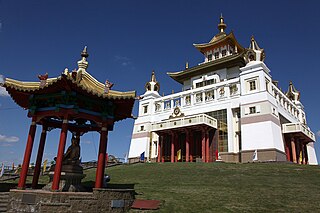
The Mongols are an East Asian ethnic group native to Mongolia, Inner Mongolia in China, and the Buryatia Republic of the Russian Federation. The Mongols are the principal member of the large family of Mongolic peoples. The Oirats in Western Mongolia as well as the Buryats and Kalmyks of Russia are classified either as distinct ethno-linguistic groups or subgroups of Mongols.

The Kalmyks are a Mongolic ethnic group living mainly in Russia, whose ancestors migrated from Dzungaria. They created the Kalmyk Khanate from 1635 to 1779 in the south of the European part of Russia territory. Today they form a majority in Kalmykia, located in the Kalmyk Steppe, on the western shore of the Caspian Sea.

Oirats or Oirds, also formerly Eluts and Eleuths, are the westernmost group of the Mongols whose ancestral home is in the Altai region of Siberia, Xinjiang and western Mongolia.

The Khalkha or Kalka have been the largest subgroup of Mongol people in modern Mongolia since the 15th century. The Khalkha, together with Chahars, Ordos and Tumed, were directly ruled by Borjigin khans until the 20th century; unlike the Oirats, who were ruled by Dzungar nobles or the Khorchins, who were ruled by Qasar's descendants.

Kalmykia, officially the Republic of Kalmykia, is a republic of Russia, located in the North Caucasus region of Southern Russia. The republic is part of the Southern Federal District, and borders Dagestan to the south and Stavropol Krai to the southwest; Volgograd Oblast to the northwest and north and Astrakhan Oblast to the north and east; Rostov Oblast to the west and the Caspian Sea to the east. Kalmykia is the only region in Europe where Buddhism is the predominant religion.

The Kalmyk people are the only Mongolic-speaking people of Europe whose national religion is Buddhism. In 2016, 53.4% of the population surveyed identified themselves as Buddhist. They live in Kalmykia, a federal subject of the Russian Federation located in southwestern Russia. The border faces Dagestan to the south, Stavropol Krai to the southwest, Rostov Oblast to the west, Volgograd Oblast to the northwest and Astrakhan Oblast to the east. The Caspian Sea borders Kalmykia to the southeast.

Erdne Ombadykow, also known as Telo Tulku Rinpoche, is the Tibetan Buddhist spiritual leader of the Kalmyk people. He received his formal training as a bhikṣu in India and was recognized by the 14th Dalai Lama as the current reincarnation of mahasiddha Tilopa.

Ja Lama was an adventurer and warlord of unknown birth and background who fought successive campaigns against the rule of the Qing dynasty in western Mongolia between 1890 and 1922. He claimed to be a Buddhist lama, though it is not clear whether he actually was one, as well as a grandson and later the reincarnation of Amursana, the Khoid-Oirat prince who led the last great Mongol uprising against the Qing in 1757. He was one of the commanders of Mongolian forces that liberated Khovd city from Qing control in 1912.

Lubsan Sharab Tepkin (1875–1941?) was a Buddhist priest of Kalmyk origin who was born in the Bokshirgankan aimak in the Salsk District of the Don Cossack Host sometime in 1875.

Menko Bormanzhinov was a Buddhist priest of Kalmyk origin who was born in the Bokshirgankan aimak in the Salsk District of the Don Cossack Host sometime in 1855.

Shurguchi Nimgirov was a Buddhist priest of Kalmyk origin who was born in the Bayuda aimak in the Salsk District of the Don Cossack Host.

Arkad Chubanov (1840–1894) was a Buddhist priest of Kalmyk origin who was born in the Iki-Burul aimak in the Salsk District of the Don Cossack Host sometime in 1840.

Djimba Mikulinov was a Buddhist priest of Kalmyk origin who was most likely born in the Ike Burul aimak in the Salsk District of the Don Cossack Host. His dates of birth and death are unknown.

Pan-Mongolism is an irredentist idea that advocates cultural and political solidarity of Mongols. The proposed territory, called "Greater Mongolia", also known as "Хамаг Монгол" usually includes the independent state of Mongolia, the Chinese region of Inner Mongolia, and the Russian region of Buryatia. Sometimes the autonomous republic Tuva, the Altai Republic and parts of Xinjiang, Zabaykalsky Krai, and Irkutsk Oblast are included as well. As of 2006, all areas in Greater Mongolia except Mongolia have non-Mongol majorities.

The Four Oirat ; also Oirads and formerly Eleuths, alternatively known as the Alliance of the Four Oirat Tribes or the Oirat Confederation, was the confederation of the Oirat tribes which marked the rise of the Western Mongols in the history of the Mongolian Plateau.

The Kalmyk Khanate was an Oirat khanate on the Eurasian steppe. It extended over modern Kalmykia and surrounding areas in the North Caucasus, including Stavropol and Astrakhan. During their independence, the Kalmyks both raided and allied with Russia in turn, engaging in numerous military expeditions against the Crimean Tatars, the Ottoman Empire, neighboring Muslim tribes, and the highlanders of the North Caucasus. The Khanate was annexed by the Russian Empire in 1771.
Anti-Mongol sentiment has been prevalent throughout history, often perceiving the Mongols to be barbaric and uncivilized people with a lack of intelligence or civilized culture.
The Noyon Khutagt is a monk of the Nyingma school of Tibetan Buddhism in the Gobi region of Mongolia. The present Noyon Khutagt is believed to be the ninth incarnation of the original Mongolian Noyon Khutagt, who himself was believed to be a reincarnation of a much earlier person in Tibetan Buddhist history.
Kalmyk Buddhist Temple, also known as Kalmyk Home, was a Buddhist temple in Belgrade, capital of Serbia. It was built in 1929 as one of the first Buddhist temples in Europe, served for the religious purposes until 1944, and completely demolished in the mid-1960s.

Tsem Tulku Rinpoche was a recognised tulku of Kalmyk descent, an incarnate lama of the Gelug school of Tibetan Buddhism, and the founder and spiritual guide of Kechara House Buddhist Association with its headquarters in Malaysia.

















